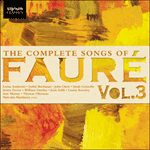This poem was discovered by the composer in a magazine that was hot off the press: it appears in Sully-Prudhomme’s 1875 collection entitled
Les vaines tendresses. Here is the quintessential Fauré for those who are not drawn to the later songs of the composer. This is music of sublime drift – the nonchalant flowing of water, seemingly uneventful, but adding up to the melancholy passing of time. Each seductively inconsequential triplet gliding between voice and finger seems to prolong a summer idyll at the same time as effacing it. Fauré was already thirty when he wrote this, and it is not the work of a teenager or wunderkind. It takes a certain maturity to be aware of water passing under the bridge, but it takes a master to be able to comment on it with this degree of philosophical calm and grace. The poet’s sentimental contention that his love will uniquely survive the passing of time seems gently but firmly refuted by the flow of Fauré’s music which is tinged with just the appropriate amount of an almost Schubertian melancholy. Like many songs of the period the vocal line launches itself with an upward leap followed by a spiralling descent of ingratiating melody rich in harmonic implications. Fauré then interleaves this principal idea with two ascending themes that make the subsequent falling phrases ever more evocative of watery ebb and flow. It is a sign of the composer’s skill that the song appears the most natural commentary on nature, that all these musical means have been conjured with seemingly the minimum of effort.
from notes by Graham Johnson © 2005
Cet poème fut découvert par Fauré dans une revue alors tout juste sortie des presses, puisqu’il figure dans
Les vaines tendresses, le recueil de Sully-Prudhomme paru en 1875. Voici le Fauré quintessentiel aux yeux de ceux que n’attirent pas ses mélodies ultérieures. La musique est, ici, d’un élan sublime – le flux nonchalant de l’eau, en apparence paisible, mais qui ajoute à la mélancolique fuite du temps. Chaque triolet, d’une insignifiance séduisante, glisse entre la voix et les doigts, semblant tout à la fois prolonger et effacer une idylle d’été. Fauré avait déjà trente ans lorsqu’il composa cette mélodie qui n’est l’œuvre ni d’un adolescent ni d’un enfant prodige. Il faut une certaine maturité pour prendre conscience de l’eau qui coule sous un pont, mais seul un maître peut l’évoquer avec un tel calme, une telle grâce philosophiques. L’assertion sentimentale du poète – son amour survivra remarquablement bien à la fuite du temps – semble doucement, mais fermement, réfutée par le flux de la musique fauréenne, nuée de juste ce qu’il faut de mélancolie quasi schubertienne. Comme dans maintes mélodies de l’époque, la ligne vocale part sur un saut ascendant, suivi de la descente en vrille d’une mélodie pateline, riche en sous-entendus harmoniques. Fauré entremêle alors à cette idée principale deux thèmes ascendants qui rendent les phrases descendantes subséquentes encore plus évocatrices du flux et du reflux aquatiques. Signe de la maîtrise du compositeur, la mélodie semble le plus naturel des commentaires de la nature, cependant que tous les moyens musicaux ont été déployés avec le minimum d’efforts apparents.
extrait des notes rédigées par Graham Johnson © 2005
Français: Hypérion


 Fauré: The Complete Songs, Vol. 3
Fauré: The Complete Songs, Vol. 3
